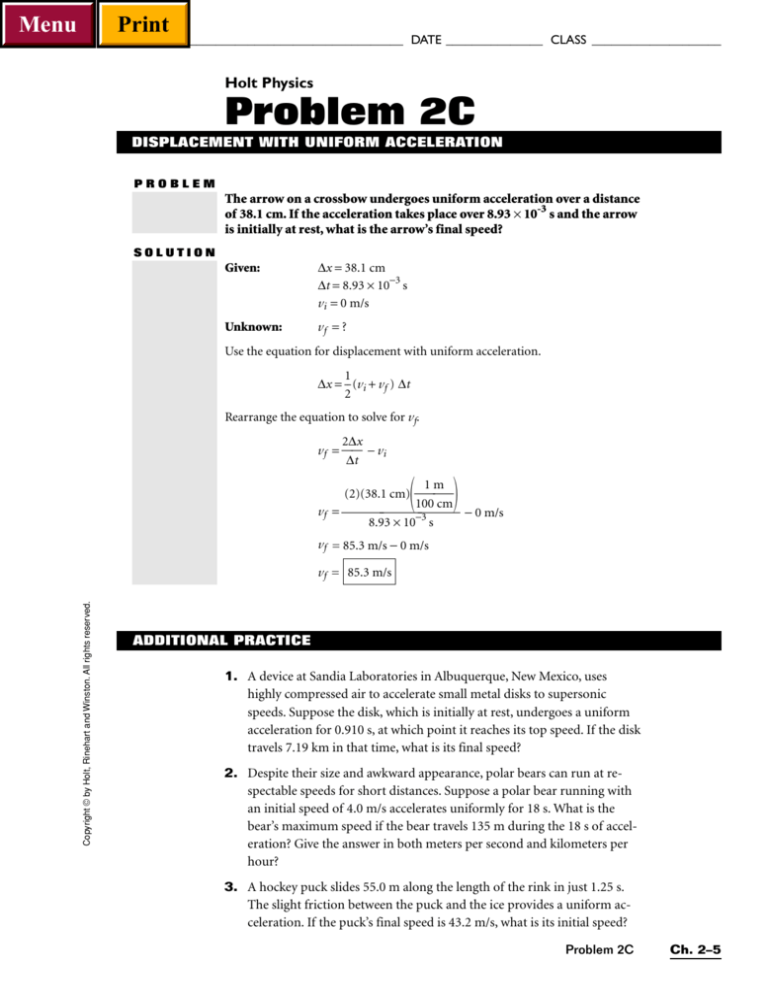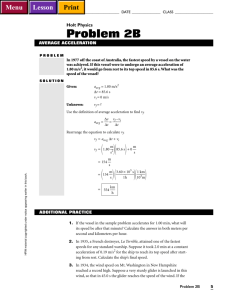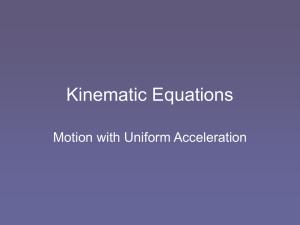
Menu
Print
NAME ______________________________________ DATE _______________ CLASS ____________________
Holt Physics
Problem 2C
DISPLACEMENT WITH UNIFORM ACCELERATION
PROBLEM
The arrow on a crossbow undergoes uniform acceleration over a distance
of 38.1 cm. If the acceleration takes place over 8.93 × 10-3 s and the arrow
is initially at rest, what is the arrow’s final speed?
SOLUTION
Given:
∆x = 38.1 cm
∆t = 8.93 × 10−3 s
vi = 0 m/s
Unknown:
vf = ?
Use the equation for displacement with uniform acceleration.
1
∆x = (vi + vf ) ∆t
2
Rearrange the equation to solve for vf.
2∆x
vf = − vi
∆t
1m
(2)(38.1 cm)
100 cm
vf =
− 0 m/s
8.93 × 10−3 s
vf = 85.3 m/s − 0 m/s
Copyright © by Holt, Rinehart and Winston. All rights reserved.
vf = 85.3 m/s
ADDITIONAL PRACTICE
1. A device at Sandia Laboratories in Albuquerque, New Mexico, uses
highly compressed air to accelerate small metal disks to supersonic
speeds. Suppose the disk, which is initially at rest, undergoes a uniform
acceleration for 0.910 s, at which point it reaches its top speed. If the disk
travels 7.19 km in that time, what is its final speed?
2. Despite their size and awkward appearance, polar bears can run at respectable speeds for short distances. Suppose a polar bear running with
an initial speed of 4.0 m/s accelerates uniformly for 18 s. What is the
bear’s maximum speed if the bear travels 135 m during the 18 s of acceleration? Give the answer in both meters per second and kilometers per
hour?
3. A hockey puck slides 55.0 m along the length of the rink in just 1.25 s.
The slight friction between the puck and the ice provides a uniform acceleration. If the puck’s final speed is 43.2 m/s, what is its initial speed?
Problem 2C
Ch. 2–5
Menu
Print
NAME ______________________________________ DATE _______________ CLASS ____________________
4. A child sleds down a snow-covered hill with a uniform acceleration.
The slope of the hill is 38.5 m long. If the child starts at rest and
reaches the bottom of the hill in 5.5 s, what is the child’s final speed?
5. The longest stretch of straight railroad tracks lies across the desolate
Nullarbor Plain, between the Australian cities of Adelaide and Perth.
The tracks extend a distance of 478 km without a curve. Suppose a
train with an initial speed of 72 km/h travels along the entire length of
straight track with a uniform acceleration. The train reaches the end of
the straight track in 5 h, 39 min. What is the train’s final speed?
6. A golf ball at a miniature golf course travels 4.2 m along a carpeted
green. When the ball reaches the hole 3.0 s later, its speed is 1.3 m/s. Assuming the ball undergoes constant uniform acceleration, what is the
ball’s initial speed?
7. A speedboat uniformly increases its velocity from 25 m/s to the west to
35 m/s to the west. How long does it take the boat to travel 250 m west
while undergoing this acceleration?
9. A hovercraft, also known as an air-cushion vehicle, glides on a cushion
of air, allowing it to travel with equal ease on land or water. Suppose a
hovercraft undergoes constant uniform acceleration, which causes the
hovercraft to move from rest to a speed of 30.8 m/s. How long does the
hovercraft accelerate if it travels a distance of 493 m?
10. A spaceship travels 1220 km with a constant uniform acceleration.
How much time is required for the acceleration if the spaceship increases its speed from 11.1 km/s to 11.7 km/s?
Ch. 2–6
Holt Physics Problem Bank
Copyright © by Holt, Rinehart and Winston. All rights reserved.
8. Airplane racing, like horse and auto racing, uses a “track” of a specific
length. Unlike the horse or auto tracks, the racing area for airplanes is
bounded on the inside by tall columns, or pylons, around which the pilots must fly, and by altitude limitations that the pilots must monitor
using their instruments. Different types of races use different arrangements of pylons to make the length of the race longer or shorter. In one
particular race, a pilot begins the race at a speed of 755.0 km/h and accelerates at a constant uniform rate for 63.21 s. The pilot crosses the
finish line with a speed of 777.0 km/h. From this data, calculate the
length of the course.
Menu
Print
Givens
Solutions
3. vi = 0 m/s
vf = 0.85 m/s forward
vf − vi
∆v
0.85 m/s − 0 m/s
aavg = = = = 0.23 m/s2 forward
∆t
3.7 s
∆t
∆t = 3.7 s
4. vi = 13.7 m/s forward
= +13.7 m/s
vf = 11.5 m/s backward
= −11.5 m/s
vf − vi
∆v
(− 11.5 m/s) − (13.7 m/s) −25.2 m/s
aavg = = = =
∆t
0.021 s
0.021 s
∆t
aavg = −1200 m/s2, or 1200 m/s2 backward
∆t = 0.021 s
5. vi = +320 km/h
1h
103 m
(0 km/h − 320 km/h)
3600 s 1 km
∆v vf − vi
aavg = = =
0.18 s
∆t
∆t
vf = 0 km/h
∆t = 0.18 s
−89 m/s
aavg = = −490 m/s2
0.18 s
1h
103 m
(386.0 km/h − 0 km/h)
vf − vi
3600 s 1 km
∆v
∆t = = =
2
16.5
m/s
aavg
aavg
6. aavg = 16.5 m/s2
vi = 0 km/h
vf = 386.0 km/h
107.2 m/s
∆t = 2 = 6.50 s
16.5 m/s
7. vi = −4.0 m/s
vf = aavg ∆t + vi
2
aavg = −0.27 m/s
vf = (−0.27 m/s2)(17 s) + (−4.0 m/s) = −4.6 m/s − 4.0 m/s = −8.6 m/s
∆t = 17 s
8. vi = 4.5 m/s
Copyright © Holt, Rinehart and Winston. All rights reserved.
vf = 10.8 m/s
vf − vi
∆v
6.3 m/s
10.8 m/s − 4.5 m/s
∆t = = =
= 2 = 7.4 s
aavg
aavg
0.85 m/s
0.85 m/s2
aavg = 0.85 m/s2
9. vf = 296 km/h
vi = 0 km/h
aavg = 1.60 m/s2
10. aavg = − 0.87 m/s2
1h
103 m
(296 km/h − 0 km/h)
vf − vi
3600 s 1 km
∆v
82.2 m/s
∆t = = =
= 2 = 51.4 s
1.60 m/s2
aavg
aavg
1.60 m/s
∆v = aavg ∆t = (−0.87 m/s2)(3.85 s) = –3.35 m/s
∆t = 3.85
Additional Practice 2C
1. ∆t = 0.910 s
∆x = 7.19 km
2∆x
(2)(7.19 km)
vf = − vi = − 0 km/s = 15.8 km/s
∆t
0.910 s
vi = 0 km/s
V
Section Five—Problem Bank
V Ch. 2–3
Menu
Print
Givens
Solutions
2. vi = 4.0 m/s
∆t = 18 s
∆x = 135 m
2∆x
(2)(135 m)
vf = − vi = − 4.0 m/s = 15 m/s − 4.0 m/s = 11 m/s
∆t
18 s
10 m
3600 s
vf = (11 m/s)
1h
1 km
3
vf = 4.0 × 101 km/h
3. ∆x = 55.0 m
∆t = 1.25 s
2∆x
(2)(55.0 m)
vi = − vf = − 43.2 m/s = 88.0 m/s − 43.2 m/s = 44.8 m/s
∆t
1.25 s
vf = 43.2 m/s
4. ∆x = 38.5 m
∆t = 5.5 s
2∆x
(2)(38.5 m)
vf = − vi = − 0 m/s = 14 m/s
∆t
5.5 s
vi = 0 m/s
5. ∆x = 478 km
∆vi = 72 km/h
∆t = 5 h, 39 min
6. ∆x = 4.2 m
∆t = 3.0 s
(2)(478 km)
2∆x
(2)(478 km)
vf = − vi = − 72 km/h = − 72 km/h
1
h
∆t
5 h + 0.65 h
5 h + 39 min
60 min
956 km
vf = − 72 km/h = 169 km/h − 72 km/h = 97 km/h
5.65 h
2∆x
(2)(4.2 m)
vi = − vf = − 1.3 m/s = 2.8 m/s − 1.3 m/s = 1.5 m/s
∆t
3.0 s
vf = 1.3 m/s
7. vi = 25 m/s west
vf = 35 m/s west
2∆x
(2)(250 m)
5.0 × 102 m
= 8.3 s
∆t = = =
vi + vf 25 m/s + 35 m/s 6.0 × 101 m/s
8. vi = 755.0 km/h
vf = 777.0 km/h
∆t = 63.21 s
9. vi = 0 m/s
vf = 30.8 m/s
1
∆x = (1532.0 km/h)(1.756 × 10−2 h) = 13.45 km
2
2∆x
(2)(493 m)
986 m
∆t = = = = 32.0 s
vi + vf 0 m/s + 30.8 m/s
30.8 m/s
∆x = 493 m
10. ∆x = 1220 km
vi = 11.1 km/s
2∆x
2440 km
(2)(1220 km)
∆t = = = = 107 s
vi + vf 11.1 km/s + 11.7 km/s 22.8 km/s
vf = 11.7 km/s
V
V Ch. 2–4
1h
1
1
∆x = (vi + vf)∆t = (755.0 km/h + 777.0 km/h)(63.21 s)
3600 s
2
2
Holt Physics Solution Manual
Copyright © Holt, Rinehart and Winston. All rights reserved.
∆x = 250 m west







